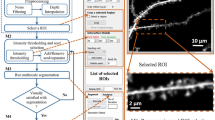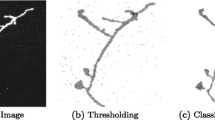Abstract
This paper presents a broadly applicable algorithm and a comprehensive open-source software implementation for automated tracing of neuronal structures in 3-D microscopy images. The core 3-D neuron tracing algorithm is based on three-dimensional (3-D) open-curve active Contour (Snake). It is initiated from a set of automatically detected seed points. Its evolution is driven by a combination of deforming forces based on the Gradient Vector Flow (GVF), stretching forces based on estimation of the fiber orientations, and a set of control rules. In this tracing model, bifurcation points are detected implicitly as points where multiple snakes collide. A boundariness measure is employed to allow local radius estimation. A suite of pre-processing algorithms enable the system to accommodate diverse neuronal image datasets by reducing them to a common image format. The above algorithms form the basis for a comprehensive, scalable, and efficient software system developed for confocal or brightfield images. It provides multiple automated tracing modes. The user can optionally interact with the tracing system using multiple view visualization, and exercise full control to ensure a high quality reconstruction. We illustrate the utility of this tracing system by presenting results from a synthetic dataset, a brightfield dataset and two confocal datasets from the DIADEM challenge.


















Similar content being viewed by others
References
Abdul-Karim, M. A., Roysam, B., Dowell-Mesfin, N. M., Jeromin, A., Yuksel, M., & Kalyanaraman, S. (2005). Automatic selection of parameters for vessel/neurite segmentation algorithms. IEEE Transactions on Image Processing, 14(9), 1338–50.
Al-Kofahi, K. A., Lasek, S., Szarowski, D. H., Pace, C. J., Nagy, G., Turner, J. N., et al. (2002). Rapid automated three-dimensional tracing of neurons from confocal image stacks. IEEE Transactions on Information Technology in Biomedicine, 6(2), 171–187.
Aylward, S. R., & Bullitt, E. (2002). Initialization, noise, singularities, and scale in height ridge traversal for tubular object centerline extraction. IEEE Trans Medical Imaging, 21(2), 61–75.
Bauer, C., Bischof, H. (2008). A Novel Approach for Detection of Tubular Objects and Its Application to Medical Image Analysis. Proceedings of the 30th DAGM symposium on Pattern Recognition, 163–172.
Benmansour, F., Cohen, L. D. (2010). Tubular Structure segmentation based on minimal path method and anisotropic enhancement. International Journal of Computer Vision, 1–19.
Boykov, Y., Veksler, O., & Zabih, R. (2001). Efficient approximate energy minimization via graph cuts. IEEE Transactions on PAMI, 20(12), 1222–1239.
Cai, H., Xu, X., Lu, J., Lichtman, J., Yung, S. P., & Wong, S. T. (2006). Repulsive force based snake model to segment and track neuronal axons in 3-D microscopy image stacks. Neuroimage, 32(4), 1608–1620.
Cai, H., Xu, X., Lu, J., Lichtman, J., Yung, S. P., & Wong, S. T. (2008). Using nonlinear diffusion and mean shift to detect and connect cross-sections of axons in 3-D optical microscopy images. Medical Image Analysis, 12(6), 666–75.
Cohen, LD., Kimmel R. (1997). Global minimum for active contour models: a minimal path approach. International Journal of Computer Vision, 24, 57–78.
Cohen, A. R., Roysam, B., & Turner, J. N. (1994). Automated tracing and volume measurements of neurons from 3-D confocal fluorescence microscopy data. Journal de Microscopie, 173(2), 103–114.
Dijkstra, E. W. (1959). A note on two problems in connexion with graphs. Numerische Mathematik, 1, 269–271.
Fiala, J. C. (2005). Reconstruct: a free editor for serial section microscopy. Journal of Microscopy, 218, 52–61.
Frangi, A. F., Niessen, W. J., Vincken, K. L., & Viergever, M. A. (1998). Multiscale vessel enhancement filtering. Medical Image Computing and Computer-Assisted Intervention, 1496, 130–137.
Freiman, M., Broide, N., Natanzon, M., Nammer, E., Shilon, O., Weizman, L., Joshowicz, L., & Sosna, J. (2009). Vessels-cut: a graph based approach to patient-specific carotid arteries modeling. Proc. 2nd workshop on: 3D Physiological Human, Springer LNCS, 5903, 1–12.
Freund, Y., & Schapire, R. E. (1999). A short introduction to boosting. Journal of Japanese Society for Artificial Intelligence, 14, 771–780.
Fridman, Y., Pizer, S. M., Aylward, S., & Bullitt, E. (2003). Segmenting 3-D branching tubular structures using cores. MICCAI, 2003, 570–577.
González, G., Türetken, E., Fleuret, F., Fua, P. (2010). Delineating trees in 2-D images and 3-D image-stacks. Proc. of the IEEE international conference on Computer Vision and Pattern Recognition (CVPR), 2799–2806.
Hamarneh, G., & Jassi, P. (2010). VascuSynth: simulating vascular trees for generating volumetric image data with ground-truth segmentation and tree analysis. Computerized Medical Imaging and Graphics, 34(8), 605–16.
He, W., Hamilton, T. A., Cohen, A. R., Holmes, T. J., Pace, C., Szarowski, D. H., et al. (2003). Automated three-dimensional tracing of neurons in confocal and brigheld images. Proc. of Microscopy and Microanalysis, 9(4), 296–310.
Kong, K. Y., Marcus, A., Young, H. J., Giannakakou, P., & Wang, M. (2005). Computer assisted analysis of microtubule dynamics in living cells. Conference of the IEEE Engineering in Medicine and Biology Society, 4, 3982–5.
Krissian, K., Malandain, G., Ayache, N., Vaillant, R., & Trousset, Y. (2000). Model based detection of tubular structures in 3-D images. Computer Vision and Image Understanding, 80(2), 130–171.
Lesage, D., Angelini, E. D., Bloch, I., Funka-Lea, G.. (2009). Design and study of flux-based features for 3-D vascular tracking. IEEE International Symposium on Biomedical Imaging 286–289.
Li, H., Shen, T., Smith, M. B., Fujiwara, I., Vavylonis, D., Huang, X. (2009). Automated actin filament segmentation, tracking, and tip elongation measurements based on open active contour models. Proc. of the IEEE Int’l Symposium on Biomedical Imaging: From Nano to Macro (ISBI), 1302–1305.
Lu, J., Fiala, J. C., & Lichtman, J. W. (2009). Semi-automated reconstruction of neural processes from large numbers of fluorescence images. PLoS ONE, 4(5), e5655.
Luisi, J., Narayanaswamy, A., Galbreath, Z., Roysam, B. (2011). The farsight trace editor. Neuroinformatics. Submitted.
Mann, A. (2010). Teams battle for neuron prize. Nature, 467, 143.
Meijering, E. (2010). Neuron tracing in perspective. Cytometry. Part A, 77(7), 693–704.
Meijering, E., Jacob, M., Sarria, J.-C. F., Unser, M. (2003). A novel approach to neurite tracing in fluorescence microscopy images. International Conference on Signal and Image Processing, 491–495.
Mohan, V., Sundaramoorthi, G., Stillman, A., & Tannenbaum, A. (2009). Vessel Segmentation with Automatic Centerline Extraction using Tubular Surface Segmentation. Int Conf MICCAI: Proceedings of the Workshop on Cardiac Interventional Imaging and Biophysical Modelling.
Narayanaswamy, A., Wang, Y., & Roysam, B. (2011). A Preprocessing Pipeline to Enhance 3-D Images of Neuronal Arbors. Submitted: Neuroinformatics.
Narayanaswamy, A., Dwarakapuram, S., Bjornsson, C. S., Cutler, B. M., Shain, W., & Roysam, B. (2010). Robust adaptive 3-D segmentation of vessel laminae from fluorescence confocal microscope images and parallel GPU implementation. IEEE Transactions on Medical Imaging, 29(3), 583–97.
Peng, H. C., Ruan, Z. C., Atasoy, D., & Sternson, S. (2010a). Automatic reconstruction of 3-D neuron structures using a graph-augmented deformable model. Bioinformatics, 26(12), i38–46.
Peng, H. C., Ruan, Z. C., Long, F. H., Simpson, J. H., & Myers, E. W. (2010b). V3D enables real-time 3-D visualization and quantitative analysis of large-scale biological image data sets. Nature Biotechnology, 28, 348–353.
Pock, T., Beichel, R., Bischof, H. (2005). A novel robust tube detection filter for 3-D centerline extraction. 18th Symposium on Operating System Principles, 481–490.
Pool, M., Thiemann, J., Bar-Or, A., & Fournier, A. E. (2008). NeuriteTracer: a novel ImageJ plugin for automated quantification of neurite outgrowth. Journal of Neuroscience Methods, 168, 134–139.
Schmitt, S., Evers, J. F., Duch, C., Scholz, M., & Obermayer, K. (2004). New methods for the computer-assisted 3-D reconstruction of neurons from confocal image stacks. Neuroimage, 23, 1283–1298.
Sethian, J. A. (1996). Level set methods and fast marching methods. Cambridge University Press.
Srinivasan, R., Zhou, X. B., Miller, E., Lu, J., Litchman, J., & Wong, S. T. C. (2007). Automated axon tracking of 3-D confocal laser scanning microscopy images using guided probabilistic region merging. Neuroinform, 5, 189–203.
Srinivasan, R., Zhou, X. B., Miller, E., Lu, J., Litchman, J., & Wong, S. T. C. (2010). Reconstruction of the neuromuscular junction connectome. Bioinformatics, 26(12), i64–i70.
Tyrrell, J A. (2006). Modeling and analysis of tubular structures in medical images: With applications to fluorescence microscopy. Rensselaer Polytechnic Institute, Phd Thesis.
Vasilkoski, Z., & Stepanyants, A. (2009). Detection of the optimal neuron traces in confocal microscopy images. Journal of Neuroscience Methods, 178(1), 197–204.
Wang, J., Zhou, X. B., Lu, J., Lichtman, J., Chang, S. F., Wong, S. T. C. (2007). Dynamic local tracing for 3-D axon curvilinear structure detection from microscopic image stack. In IEEE International Symposium of Biomedical Imaging (ISBI), 81–84.
Wearne, S. L., Rodriguez, A., Ehlenberger, D. B., Rocher, A. B., Hendersion, S. C., & Hof, P. R. (2005). New Techniques for imaging, digitization and analysis of three-dimensional neural morphology on multiple scales. Neuroscience, 136, 661–680.
Xie, J., Zhao, T., Lee, T., Myers, E., & Peng, H. (2010). Automatic neuron tracing in volumetric microscopy images with anisotropic path searching. MICCAI, 13(2), 472–9.
Xu, C., & Prince, J. L. (1998). Snakes, shapes, and gradient vector flow. IEEE Transactions on Image Processing, 7(3), 359–369.
Yuan, X., Trachtenberg, J. T., Potter, S. M., & Roysam, B. (2009). MDL constrained 3-D grayscale skeletonization algorithm for automated extraction of dendrites and spines from fluorescence confocal images. Neuroinformatics, 7, 213–232.
Acknowledgements
This work was supported by NIH Grant R01 EB005157.
Author information
Authors and Affiliations
Corresponding author
Rights and permissions
About this article
Cite this article
Wang, Y., Narayanaswamy, A., Tsai, CL. et al. A Broadly Applicable 3-D Neuron Tracing Method Based on Open-Curve Snake. Neuroinform 9, 193–217 (2011). https://doi.org/10.1007/s12021-011-9110-5
Published:
Issue Date:
DOI: https://doi.org/10.1007/s12021-011-9110-5




